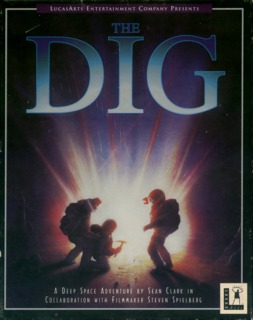The Dig has the atmosphere and isolation of Metroid, the puzzles of Myst and the story from a good episode of Stargate.
Why does everybody talk about Boom Blox like it was Steven Spielberg's first entry as a game designer when his first real attempt at making a game was The Dig. Originally released in 1995, The Dig far surpasses Boom Blox in scope. The game received an unprecedented amount of media attention because of Spielberg's connection to the project and it became infamous for it's prolonged time in development. But what we got was well worth the wait.
You play as astronaut Boston Low. NASA has appointed you with the task of halting the impending impact of an asteroid they've named Attila. After you and your crew correct the decaying orbit of the rock you are tasked with exploring it, leading you to quickly discover it's alien origins. While exploring the inside of the asteroid you unwittingly activate it and it sends you and your crew to an alien world. This planet is beautiful and filled with many wonders, and many perils. You will have to learn how to operate the alien technology on the dystopian planet if you are to discover what happened to the people who lived there and how to prevent your crew from falling into the same fate.
Presentation:
The game features beautifully hand painted enviroments and motion captured character sprites. The alien world seems original and believable, not to mention occasionally breathtaking. The musical score captures the feeling of solidarity and the wonder of discovery. The voice acting is top notch and the rest of the sound work is up to the same level of quality. The writing is where the game really shines and it's definitely up to the level of great sci-fi novels and television shows. The character interaction is how most of the story progresses so it's a good thing that their dialogue is so well written as well.
Gameplay:
The Dig is harder than most LucasArts games. The puzzles are harder to figure out at first but it's still easier than most Sierra games. Perhaps what hurts The Dig the most is it's lack of direction and goals for your character. The underlying goal of getting everybody back to earth is always there but everything inbetween you'll need to figure out for yourself. The game doesn't have much direction until you get to the final part, but this is all part of the concept of exploration that is unique to The Dig when compared to other LucasArts classics. Being dropped into this big world with very little idea of what to do next may seem a little daunting at first but after completing the game you wouldn't want it any other way.
Tech:
LucasArts fans will be glad to see that for the re-release the company hasn't taken the easy way out and packaged the game with freeware software like DOSBox or ScummVM to make it operate in Windows. Instead they have programmed a DirectX version of the original engine. The Dig runs native in a Windows 32-bit enviroment. Improvements include an upscaler, much like the one seen in Sega's recent Genesis collection for 360 and PS3 that smooths out the edges of the sprites and gives them a more modern look. Otherwise the game looks and sounds like it did back in 1995. But you can rest assured that you wont have any trouble running the game on your new machine.
The Dig has the atmosphere and isolation of Metroid, the puzzles of Myst and the story from a good episode of Stargate. The exploration and trying things with little direction can be a little intimidating at first but eventually you will get into the rhythm of things and the pay off of a beautifully crafted and well told story is well worth it.

